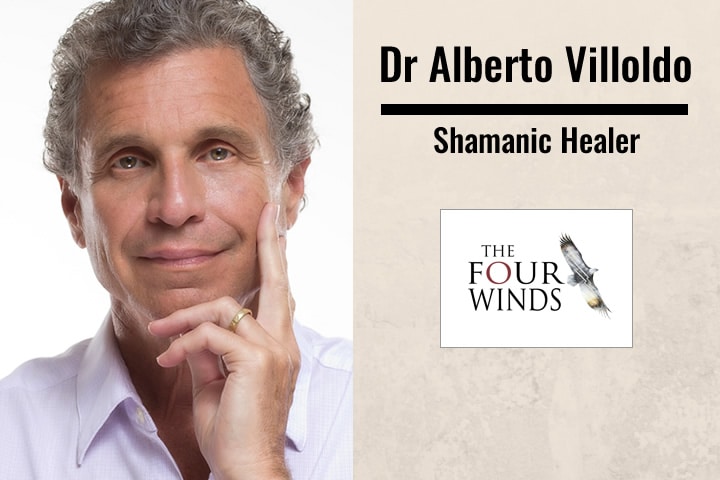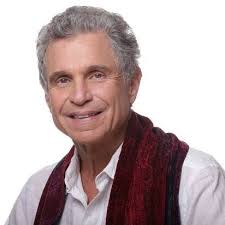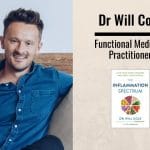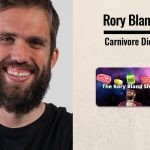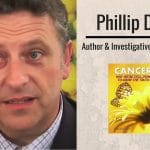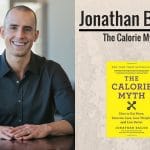Watch the full interview below or listen to the full episode on your iPhone HERE.
Stu: This week, I’m excited to welcome Dr Alberto Villoldo back to the show. He is a psychologist and medical anthropologist who has studied the shamanistic healing practices of the Amazon and Andes for over 30 years. He’s the founder of The Four Winds Society, an organisation dedicated to bridging ancient shamanistic traditions with modern medicine and psychology.
Audio Version
Questions we ask in this episode:
- What led you to explore shamanism?
- What did you learn during your time in the Amazon?
- How does a shamanistic philosophy view modern-day living?
Get More of Dr Alberto Villoldo
If you enjoyed this, then we think you’ll enjoy these interviews:
- Dr Bruce Lipton – At Last, Scientific Proof of How Our Thoughts Can Make Us Healthy or Sick
- Alicia Lynn Diaz – Combining Ancient Ayurvedic Wisdom With Modern-day Science
- Tom Campbell: Nature Of Reality, Beating Fear & The Meaning Of Life
Full Transcript
Stu
This week, I’m excited to welcome Dr. Alberto Villoldo. Dr. Villoldo is a psychologist and medical anthropologist who has studied the shamanistic healing practices of the Amazon and Andes for over 30 years. He’s the founder of The Four Winds Society, an organization dedicated to bridging ancient shamanistic traditions with modern medicine and psychology.
In this episode, he shares his experiences in the Amazon and discusses how he teaches people to grow new bodies that resist disease through modern day shamanistic rituals. Over to Dr. Villoldo.
Hey guys, this is Stu from 180 Nutrition, and I’m delighted to welcome Dr. Alberto Villoldo to the podcast. Dr. Villoldo, how are you?
Alberto
01:53 I’m well. Thank you.
Stu
01:55 Thank you so much for sharing your time. And I know that you’ve got a very unique story that we’re going to dig into this morning, and it’s going to take us on a little bit of a different journey. But before we get into that, I would love for any of our listeners that may not have heard about you or your work, just to tell us a little bit about where you started and why you do what you do, please.
Alberto
02:18 Just in a nut shell, I’m a medical anthropologist and I’ve spent the last 30 years traveling through the Amazon and the Andes mountains and throughout the jungles of the world to study the shamans, the medicine men and women that create health. They don’t treat disease. Their practice has to do with creating the conditions for health, and then disease goes away or does not manifest.
In contrast with our Western medical practice, where we don’t really have a healthcare system, we have a deceased care system. The shamans that I work with focused on creating health, psychosomatic health, health through your foods, your diet, nutrition, through your breathing practice, your sleep, and of course, through the luminous energy field that surrounds the physical body and organizes it.
Stu
03:19 Wow. So very different, a very different paradigm to conventional medicine, and I think looking at a whole manner of things that wouldn’t even enter into many of our minds these days as well. So I’m intrigued by the word shaman, and I wondered if you could expand on that just a little bit in as much as, when I picture a shaman, I’m thinking about a traditional medicine man in the Amazon, in a rainforest, who is essentially the healer of a tribe or a village. Is that a traditional shaman? Is that a modern day shaman? Are there modern day shamans that live in cities? What’s your take on that?
Alberto
04:07 That’s a really good image. That’s the classical shaman image, and that’s how I normally dress up in the morning with my feathers and my tattoos. I just put this shirt on for our interview.
The modern shaman is someone who’s versed in the ways of the West and in the ancient medicine and who’s not caught in this Western medical model, which is what I call Farmageddon, which is based on chemicals.
Stu
04:37 Yeah.
Alberto
04:37 It’s based on treating disease. If you deviate from the standard protocols of treatment, you basically get fined or sued. And that doesn’t look at the body as a system. We have cardiologists that look at the heart and neurologists that look at the brain and gastroenterologists that look at the gut, and they will talk to each other.
Stu
05:03 Right.
Alberto
05:03 More than a collection of parts, we need people that are systems oriented and that look at the entire body, and the body as well as the spirit, as well as the field, the energy field, because we’re energy beings.
Stu
05:20 Where did your interest come from for shamanism? Did you have an itch that you wanted to scratch? Were you looking at the medical system and thinking, “Something isn’t quite right. I think there’s more somewhere?”
Alberto
05:40 No, actually. I was directing a laboratory at San Francisco State University, and we were looking at the brain and how the brain creates psychosomatic disease and wondering if we could create psychosomatic health.
Stu
05:58 Right.
Alberto
05:59 And after a couple of years of slicing and dicing and staining the brain and looking at a number of different protocols, I decided I was looking out of the wrong end of the microscope. Instead of going smaller and smaller, I had to go bigger, even to the point of working with peoples who had a different conception of time and space and reality than we do in the West.
So I closed my lab and I traded my lab coat for a pair of hiking boots and went off to the Amazon to study the shamans that only had the power of the mind and their medicine plants, but the power of the mind to heal. And over the years of training with them, I became a shaman. If you cut wood in a carpenter’s studio long enough, you become a carpenter.
Stu
06:52 Yeah.
Alberto
06:52 But my work is really about integrating ancient science and modern wisdom or modern science and ancient wisdom.
Stu
07:03 So tell us about what you learned. And I know that’s a loaded question because there is so much, no doubt. But what were the fundamentals do you think that we could perhaps start to consider to apply to ourselves in modern day living?
Alberto
07:20 Well, I’ve written 20 books about this, and probably the best one that describes that is called Dance of the Four Winds. But here, the shamanic teachings are very applicable today because they have a 50,000 year-old body of wisdom for creating health and longevity.
I’ll give you an example. The secret plants of the shamans are not the psychedelic plants, those like the Iowaska and San Pedro that are everywhere in the world today. Those are the teacher plants.
Stu
08:00 Right.
Alberto
08:01 But the sacred plants that switch on. When we took them to the laboratory, we found that they switch on more than 200 genes that create health and switch off more than 500 genes that create disease. And they work along a pathway that we’ve identified today, that we call the Nrf2 detox pathway.
Stu
08:01 Right.
Alberto
08:26 That you find in resveratrol and curcumin and sulforaphane. So I asked the shamans, “How did you know that these plants,” and around the world, this is the case, there are sacred plants, Nrf2 activators. “How did you know that these plants switch on the genes that create health and silence the genes for breast cancer and heart disease and dementia? And they go, “Easy.” I said, “How did you know?” They said, “The plants told us.” So I said, “Well, is there a B explanation? Is there something that has a little more science in it?”
Stu
09:10 Yeah.
Alberto
09:11 Then, I remember this medicine woman asked me to open my hand and I did. And she put a wad of chewing gum in it.
Stu
09:20 Right.
Alberto
09:20 And I asked her, “What is this?” She said, “That’s curare.” Now, curare is a neurotoxin.
Stu
09:29 Yeah.
Alberto
09:30 It’ll kill you very rapidly by paralyzing you, but you’re totally conscious. It’s a pretty terrible way to die. But they use it for hunting. They’ll put the tip of a dart in curare, and only when it touches the blood, this will become a neurotoxin.
Stu
09:48 Okay.
Alberto
09:48 So I dropped it immediately. She said, “No, it’s okay. It’s safe. You can even swallow it and you’ll poop it out.” And curare is the basis of Western anesthesia.
Stu
10:02 Right.
Alberto
10:03 And I asked, “How did you learn about curare?,” because it takes seven different plants that had to be boiled exactly for five and a half hours without inhaling the very flowery smell, delicious scent that you inhale and you die within 20 seconds. “How did you know which seven plants to put into this mix and what proportions?”
And she says, “The plants told us.” Okay? She’s like, “Don’t you talk to the plants where you come from?” I go, “No.” And it reminds me a story that when the conquistadors arrived in Peru, they met with Inca, the ruler. And they brought a priest, and the priest gave him a Bible. And the priest said to the Inca, who was a shaman, he said, “This is the word of God.”
Alberto
11:00 And the Inca took the book and he put it to his ear and he listened and he couldn’t hear anything, and he threw the book down and he said, “What kind of God is this that does not speak? And when did your God last speak to you?” And the [inaudible 00:11:18] said, “Well, about 1500 years ago,” and he said to the Inca, “When did your God last speak to you?” He said, “This morning at breakfast.” So these were people that have not been kicked out of the garden of Eden that, still spoke with God and with the rivers and with the trees and with the plants, and they communed with nature and nature told them what plants were good for creating health, what plants were good for longevity. We have this ability to dialogue with all of nature, but we’ve shut it down because of our disconnection with nature and because of how toxic our bodies are today.
Stu
12:02 So question then, do the plants speak to you?
Alberto
12:08 Yes.
Stu
12:11 Okay.
Alberto
12:11 But only when I asked them questions.
Stu
12:16 So tell me, how does that work? How would you transition then from a westerner with Western idealisms and westernized dogma, to a culture that is so radically different to everything that you’ve ever known to then become part of that culture? How did that work?
Alberto
12:38 Well, it took me a long time and I started out as so as an anthropologist, which means that you observe, you document, you film, you record, you take notes, and I realized that that kept me in a subject object relationship.
Stu
12:56 Right.
Alberto
12:56 I had to objectify –
Stu
12:58 Yeah.
Alberto
12:58 – what I was studying, and after a couple of years of that, I basically left all my notes and I saved them. That became the basis of my books, but I started doing participatory anthropology, where I actually cooked and lived and cleaned and hiked and trekked and meditated and did ceremony with the people I was studying with, integrated, but initially I was received and welcomed because my first forays, particularly into the high mountains, I saw that in working with people that had never had any contact with the West, but had had contact with other Indians that have brought the illnesses of the West, and I saw that many of the children were afflicted with conditions that in the West we treat very readily, like intestinal parasites and worms and skin infections. So I started taking Western medicine with me, medication, which any kindhearted person would do that.
Stu
14:14 Yeah.
Alberto
14:15 So I was received as a healer of sorts and welcome and given access to their elders and to this world of energy and healing that we only suspect in the West.
Stu
14:34 So how do your philosophies now … so your shamanistic philosophies and everything that you have learned and discovered over the journey, how do you view modern day living now and how perhaps do you fuse those two worlds?
Alberto
14:54 Well, I think we are returning to a more natural worldview, a more organic, a more holistic, less fragmented and integrated world that we want to create and live in, and a hundred years ago, the conversation in physics was whether the electron was a particle or a field or a wave, and they discovered that it was both, that it had a particle state and that it had a field state.
Stu
15:24 Right.
Alberto
15:24 Well we are the same. We have a particle state, which is our body, and then we have a field state, which is the energy field around the body that connects us with the quantum field that we’re all a part of, and I remember asking a shaman that I was working with one time, “What’s the object of all of this training in shamanism?” And they said, “Well, the object of it is to learn how to get out of this life alive.” How do you take your consciousness with you when you leave the particle state and you go only into the field? You’re only an energy field now. Remember, the field extends to infinity. It doesn’t stop like my skin stops here. The field gets weaker and weaker, but it extends to the farthest reaches of the universe, where we are part of the quantum field. So how do you retain consciousness? This is what the Tibetans were fascinated with, what the Native Americans were fascinated with, their wisdom keepers. Their simple healers were interested in mending a cut and healing of bone, but their wisdom keepers understood that we were on a great journey through the stars, through infinity, and that we had to carry our consciousness with us or we would not be there to witness it.
Stu
17:00 Then your thoughts on technology? Because for those who are deeply rooted in the tech world, have been talking about how we would transition from our physical lives into more of a technological entrapment as we age and as technology and artificial intelligence and things like that start to progress even further, almost to the degree of technological implants that then would see our … well, I won’t say soul, but it would see our minds shifted over to a different vessel, but having access to the internet and being the internet forever, and I’ve listened to people like Elon Musk, who was saying we’re in very frightening times because technology is entrapping us now. It almost sounds like there is a similarity, but of polar opposites there.
Alberto
18:08 Well, there’s a similarity except that the … if you read Ray Kurzweil, who was head of Google’s far out lab, and he talks about the singularity that’s happening at this time, when the machines get smarter than we do. And if you upload yourself to the cloud, the problem is that you’re uploading your personality, and that’s with all of your psychological issues and problems. So this is complicated. What the spiritual traditions around the world understand is that we are not our name, our personality, our gender, that we’re not our bodies, but we are … the body is a temple. So there’s an awakening process that occurs when you discover that part of you that is literally conscious and awake in the field, and that became the essential healing journey of the shamans, because it was not repairing the hurt. You had to stop the bleeding, of course, but it was helping your student or your patient to learn the lesson so they didn’t have to repeat the grade again, and this is essential.
This is this the core I teach our students, and when I do today is I train Western shamans that are versed in neuroscience and they’re versed in the energy medicine of the ancients. So we can use nutrition and diet and NR2 activators and upgrade mitochondria, which is what turns … mitochondria basically are the fuel factories in ourselves and they regulate the death clock. They tell us when they need to [inaudible 00:09:02], but they store energy in the form of light. They produce ATP, which is light, basically, phosphorous. So we eat plants that turn light into life and we then bust these plants, turn them back into light, and that’s what we use for fuel. So we’ve gotten kind of pretty far out there into left field, but the interesting thing you said today, we have the science and we have the ancient wisdom and they can meet, and we know that you cannot just treat the body or treat disease, but you need to create health, and we know that health is created physically and emotionally, and if you can clear the trauma that is in the body and in the field, then you can create exceptional health.
Stu
21:04 Yeah. I’m very fascinated by this, because I think there are two camps. There are those that truly want to embrace and feel like there’s something else that they need to discover to be able to even start the journey that you took many years ago, and then on the other side, there are the scientists and the biohackers who are taking antiaging supplements and who are utilizing saunas and ice baths and hyperbaric oxygen chambers in order to try and live as long as we can. If we’re wanting to truly embrace and understand more about the traditional practices, where would we go to start?
Alberto
21:56 Well the fun part is that half of the
22:01 … NTAG hackers, biohackers, come train with us. They’re deeply steeped, steeped very deeply into the energy field and into the spiritual side of life from Dave Asprey to David Perlmutter, to … I don’t know if you know David Perlmutter’s work, Grain Brain?
Stu
22:25 I do yeah, we’ve had him on the podcast twice. He’s unbelievable character, very passionate.
Alberto
22:30 Great. He and I wrote a book together actually, called The Neuroscience Of Enlightenment. So these two worlds have met, and they met in the field of longevity. I’ll tell you an interesting fact, because I have a science background, but after 25 years in the Amazon, you step beyond the limits of science. See, science today has become a religion, has become dogma, not physics, but medical science and the heads of the New England Journal Of Medicine. The British Journal of Medicine say that half of the articles they publish are bogus but they don’t know which half, the sample sizes are too small.
So there are 40 million species on the planet and you probably know this, but out of those 40 million species, only three species does the female live to become a grandmother, does a female going to menopause. Every one of the other 39.99 million species, the female dies when she’s no longer reproductively viable. Those three species are humans, whales, and dolphins. We don’t have a death program in our DNA. One of three species that do not have a death program.
We’re taking part in an experiment in longevity that biology wants us to take part in and these are the three species that have the highest brain to body weight ratio. This is an experiment in intelligence and intelligence is not IQ, it’s not gadgetry. Intelligence is what we have called spirituality for a long time. But it’s not this fuzzy spirituality that I’ve got to have a nice feeling in my stomach about. No, it’s about exploration, about discovery, about the discipline of mind.
So we’re part of this experiment and we can take part in it consciously, but we need to detox the body, detox the brain, use the neuro-nutrients, the brain supplements, and then awaken the higher brain through ketosis and start burning fat for fuel and then we can take part in exploring these ancient maps.
Stu
25:05 Fantastic. I love the way that you talk about tradition, ancient traditions, but then fuse in modern day phrases now, like ketosis and NRF pathways and all of the terminology that most of our listeners would have heard of and are actively exploring at the moment. So The Four Winds Society, because I’m keen to understand how we can learn more, our listeners can learn more and dial into your learnings and try and apply it to themselves to discover everything that you have. So I’m intrigued about The Four Winds Society.
Alberto
25:46 Well, The Four Winds Society is actually a training organization where we train modern shamans, basically people that are versed in energy medicine and in brain science, particularly, but with a strong interest, emphasis in how you eat, in a primarily plant-based diet and lowering mTOR, lowering the sugars in your system and these sugar markers, particularly IGF-1 and mTOR. These are the two ancient regulators in longevity. We can work with them creatively, we can start creating health at a physical level.
Then at the energetic level, we teach our students how to track for the stale chi that is in the field and how to clear it. The stale chi is created by trauma. This is parts of the field that the energy is not flowing cleanly on. If you go to an acupuncturist, they’ll find that on the meridians and put needles in them.
What we do is we track it in the field. We eliminate it from the field and we upgrade the quality of the information in the field. It’s an information field. It’s not a reservoir of fuel, it’s that energy as fuel, but it’s energy as information. You know, we used to think about food as calories.
Stu
27:12 Mm-hmm (affirmative).
Alberto
27:12 And now realize that food is information. The same way we used to think of energy, the energy field, as fuel when it’s really information about how to organize the body and how to prepare you to the journey beyond death. So this is what I do today through The Four Winds. We train health coaches, energy medicine practitioners, that are able to integrate the modern, the longevity work and the ancient.
Stu
27:50 Technology then. How does technology play a part in your life? Given the fact that since the advent of the internet and smartphone computers, many of us now almost have been reprogrammed into habits that include continual connectivity to the internet and are almost becoming quite disastrous in the fact that we’re now plugged into the internet with all of its interruptions for so long, that we’ve almost lost the art of being in the moment, observing nature, because we’re so sidetracked on taking the next Instagram picture or Facebook message. How does it work with you, because you’ve come at it from the completely opposite side?
Alberto
28:47 You know, I use the technology and I … Excuse me. So we use a lot of technology and what we do, we actively are doing virtual conferences and we use the internet, but we use it creatively. We don’t think it’s a place that you want to take up residence in. I think that it can be very seductive and it mimics but forestalls, but prevents the deep engagement that you want to have with the other. So I think that we’re just learning how to work with the technology. It’s like when we started learning how to make fire. There was a time that the world was lit only by fire and we learned how to use fire about 800,000 years ago but we only learned how to make fire about 300,000 years ago.
So for 500,000 years, the keeping of the fire was the most important job in the village. If the fight went out on your watch, it might be 10,000 years before you got it again. So at the beginning of learning how to make fire, we had to go through a lot of technology that didn’t work. And we burnt ourselves quite a bit, burnt buildings down houses, and how do you contain fire and cook with it, without it? And the same with the modern technology, how do we not get burnt by it and use of creatively? It’s extraordinary what we can do with it, but you cannot hide in it. You cannot hide your feelings and you cannot hide your pain and your hurt in it.
Stu
30:44 I’m thinking now about people who want to learn more and have been listening and following similar stories, I guess, from the internet, from podcasts, from blog articles and the like. There is a very big plant-based journey, I think that any of us can take at any given time, that could include things like psychedelics, mushrooms, veganism, all the way to ayahuasca, which now seems to be something that you can find almost in any city now, you can have an ayahuasca journey. How does that sit with a shaman? Because I think that surely that is just cheapening, perhaps dangerous, and it could be anything but beneficial for us?
Alberto
31:53 Stuart, I love how you clump veganism in there with psychedelics, it’s just great. Can I quote you on that. Can I use that?
Stu
32:00 Yes, please.
Alberto
32:03 It was fantastic, I love it. I love it. Okay, so here’s the key. I think that it’s interesting how the whole paleo movement really shifted gears as soon as the research on mTOR came about [inaudible 00:10:18], that it’s not meat-based, that you’ve got to cut back on the protein if you want to live long, if you want to go into repair and regeneration. Now, the psychedelics are really important. They’re really, really important and I’ll tell you why. Because their old brain, our Neanderthal, limbic brain has a fight or flight system in it. The fight or flight system produces adrenaline and cortisol and cortisol is poison for the brain. It damages the brain, it damages the centers of learning in the brain, the hippocampus.
33:01 But if you can quiet the production of cortisol and adrenaline, quiet down the fight or flight, very difficult to do because most systems in the body are feedback systems but this is a feed forward system. So the more you stimulate it, the more adrenaline you produce, the more stimulated, you want to get incaffeinated. But if you can quiet it down with the Omega 3s, DHA or great sex, we’ll do it, or meditation will also do it, then you are able to step into the higher brain. Again, you’ve got to get out of the sugars. The old brain runs on sugars. You start eating the good fats and burning fat for fuel.
In the higher brain, the pineal gland will begin to methylate. And it’ll take serotonin, which is a common neurotransmitter, most of it produced in the gut. 85% of your serotonin is in your gut by your good gut flora. It’s not produced by candida, which is what you get when you eat a lot of sugar and work on the sugar brain. You get proper amount of serotonin. You’re not producing adrenalin and cortisol. You kick on the higher brain and you will transform serotonin into melatonin so you can sleep. But if you tweak, serotonin is a tryptamine, is 5-HT. That’s a formula for it. If you add a couple of methyl bonds to it, you get dimethyltryptamine.
Stu
34:43 Right, right.
Alberto
34:44 Which is DMT, which is ayahuasca. The brain produces it naturally. In order to meditate, you need to have the substrate. You need the brain chemistry to be able to get calm. If you’ve got a lot of adrenaline in your brain, you’re not going to be able to meditate. If you are producing the bliss molecules, then all you do is meditate. People ask me, “Alberto, how long do you meditate for?” I tell them, “Well, I’ve got it down to about 23 and a half hours a day,” because that’s the feeling of interconnectedness with all things that you get to from the higher brain, when you’re methylating serotonin. And it happens when we dream, it happens when we make love, it happens when we die. Burst of DMT, of ayahuasca, produced by the brain. This is a psychedelic.
So there’s a place for these plants, but only in a secret setting. And to me that meant in the Amazon, but there’s a lot of people getting a lot of good benefit from working with these plants a little bit too casual. They don’t go preparation or the diet, and they don’t go through the brain upgrade that I have in my book, Grow a New Body. You got to repair the brain, otherwise you see God on Saturday night on ayahuasca and you can’t remember when you had for dinner with God or what you talked about two days later.
So this is the beauty of the times that we’re living in. We know how to do this. And we know even how to grow a new body that ages and heals and dies differently. And what I tell my students is that for the shaman, there’s no difference between being killed by a microbe or being killed by a jaguar. You’ve got to be in good relationship with microbes and viruses and jaguars otherwise you’re both going to be looking at you as lunch. And we do that by creating health and by wakening our connection with all of life.
Stu
37:05 Wow, there will be a lot of people that want to learn a lot more about this and about your journey and dig into your books as well. And I’m mindful of the time. Before we end the conversation, I’d just love to touch on some non-negotiables that you would personally practice every single day. Some, I think, things that have been built in and become habitual over the years with your learnings. So what would your day look like? What are these non-negotiables that you would become your baseline things that you can’t live without, things that you absolutely have to include every day
Alberto
37:52 Besides breathing?
Stu
37:53 Besides breathing.
Alberto
37:56 I would… That’s a great question actually. It’s an excellent question. But when I do every morning is that I take about five minutes before I get out of bed and I review my dreams. And there is some mastery of the dream state that is really important for, among the shamans that I studied with. And many of us wake up in the morning and we realized that we’ve dreamt, but we can’t recall what we dreamt.
Stu
38:26 Yeah.
Alberto
38:28 And in our dreams, the most amazing things happen. I had a dream that I was with my father having dinner on a galleon, on an ancient ship, beautiful meal, white tablecloth, nice bottle of wine. And he was younger than I was and this dream, and it felt perfectly natural. And there was a technique that we use to remember our dreams, which is to take a glass of water, small glass, and drink half of it and tell yourself, “When I drink the other half of water in the morning, when I wake up, all of my dreams will come back to me.” And then in the morning and wait five minutes and wait for your dreams to come back. And after the third, fourth or fifth time you do it, your dreams will come back to you and you’ll see what amazing journeys you’ve been taking.
Stu
39:23 Wow.
Alberto
39:25 Now the more advanced practice is that you drink half of the glass before you go to sleep and then you drink the other half of the glass while you’re dreaming so that you can wake up inside the dream.
Stu
39:41 Right.
Alberto
39:43 You drink the physical, you just wake up inside the dream. And if you can do that, then you can wake up inside the dream that we’re having right now.
Stu
39:56 Boy, oh boy. Well, certainly lots of questions. And again, many of our listeners right now will have too many questions to ask.
Alberto
40:08 There’s a great resource for our listeners that if you want to visit my website, we have a lot of free resources.
Stu
40:16 Yeah.
Alberto
40:17 My mission is to train and to open the world of the shaman to the world today. So it’s thefourwinds.com. The four, F-O-U-R.
Stu
40:30 Yeah.
Alberto
40:30 winds.com, W-I-N-D-S. And check our resources and our videos and our 10 day detox program. That includes an emotional detox as well as a brain detox that I developed with David Perlmutter actually.
Stu
40:49 Okay, fantastic. Well, look, we will put all of the links in the show notes. And just before we go, what’s next? What have you got in the pipeline for 2020?
Alberto: 41:03 Well, there’s a lot of big things happening in the world today and happening within the context of the big extinction event that’s taking place, many, many species being lost. And when we have extinction events, evolution goes from working on a Newtonian, from physics framework, to working with a loss of quantum mechanics, so that it’s no longer slow and incremental, but evolution begins to take quantum leaps. It’s no longer evolved being in between generations so that your children maybe will be smarter and handsomer, but within generations, we can uncoil our DNA another strand, and then take a quantum leap into becoming and look human that’s appearing on the world today, that ages differently and heals differently and dies different. And I think that this is the opportunity that we have available to all of us. We keep looking to take that quantum leap. It’s not a matter of can we anymore, but dare we.
42:19 Fantastic. Well, Dr. Villoldo, thank you so much for your time. Again, so many questions that I would like to ask. We’ll share everything that we’ve spoken about on the website with the show notes and point our listeners as well to the Four Winds and to find out more about you and your work. But thank you again, I really appreciate your time and hopefully we will chat at some stage in the future.
Alberto
42:47 Thank you, blessings, and what a beautiful part of the world you’re in. Thanks so much.
Stu
42:52 Thank you. Bye-bye


